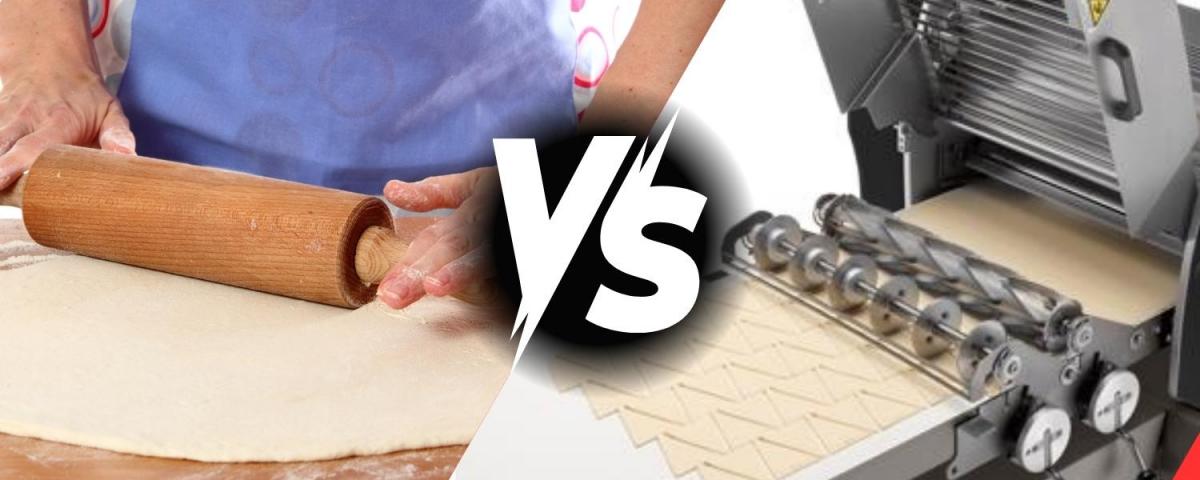Dough Sheeters VS Manual Rolling: A Comparative Analysis
There are obvious reasons why a dough sheeter is more optimal than manually rolling out dough, but there are other factors when comparing the two that most may not recognize. At Empire we have been a leading industry expert in bakery equipment and solutions for over 45 years and spreading our knowledge with bakers is something we take a great deal of pride in. In this article, we will be going over in great detail the major differences between automated dough sheeting and manual rolling to better educate the baker on the benefits of using an automated system.
Traditionally, bakers relied on manual rolling to sheet their doughs, but the advancement of technology and the increase in demand for baked goods has driven many bakeries to switch to dough sheeters. Dough sheeters were always thought to only be a necessity for large retail or wholesale bakery operations, but that simply is not the case anymore. Smaller compact tabletop sheeters are being offered for smaller workloads and bakeries with small bakery space. Let’s take a look at the major differences in automated and manual dough sheeting and allow you to come to your own conclusions.
Consistency & Precision
Dough Sheeter:
Dough sheeters allow bakers to use a digital control panel to set the desired thickness of their sheeted dough. The machine will adjust its rollers to ensure you are getting a precise thickness of dough. This is great for consistently producing a uniform product each time which resonates well with your repeat customers. Being able to adjust your thickness with accuracy also allows you to make a variety of different products from croissants to cookies and pie crusts with ease!
Manual Rolling:
Manual rolling relies heavily on the skill and experience of the baker. However, even the most skilled bakers will find it challenging to achieve the same level of precision and uniformity that an automated machine can provide. Not to mention the constant back and forth of rolling and measuring over and over until you get the desired thickness is extremely time-consuming.
Time and Labor Efficiency
Dough Sheeter:
The efficiency of a dough sheeter is unmatched. Automating your dough sheeting process saves you significant time and labor in your production process. Getting consistent and even sheeting of your dough each time is such a valuable asset to a baker. One person running and easy-to-use automatic dough sheeter can do the work of multiple people manually rolling out dough. This does not only save you time, but it will also save you money on labor costs allowing the machine to eventually pay for itself.
Manual Rolling:
Rolling out dough manually can be time-consuming and physically demanding. This is even more true when dealing with large batches and production cycles. Keeping up with the production of an automated dough sheeter would require multiple rounds and a larger staff of bakers. These factors can slow down the baking process and add to labor costs.
Dough Quality
Dough Sheeter:
Most doughs that need to be sheeted are delicate and require gentle handling. Dough sheeters are capable of gently handling any type of dough and with a high level of consistency. Sheeters will always produce doughs with a smooth texture and even thickness, which then leads to a better and more consistent end product.
Manual Rolling:
When doing anything manually, you have to take into account human error. Even the best bakers in the world cannot guarantee consistency the way machines can. The manual process of sheeting dough can also sometimes result in overworking the dough and in part affect the overall texture of the dough. On top of this, manual rolling often leads to uneven thickness of the sheeted dough which leads to inconsistent final product.
Versatility
Dough Sheeter:
Most dough sheeters offer attachments and adjustable settings that allow for the machine to accommodate a variety of different products and processes. Empire dough sheeters offer cutters for a variety of products like doughnuts and croissant cutters that evenly and consistently cut the dough after it is sheeted.
Manual Rolling:
Simply put, manually rolling out dough and cutting it to the desired shapes and sizes is a tremendous amount of work, especially when doing large quantities. Not to mention, some doughs are tougher to roll manually or extremely delicate which results in inconsistent sheeting.
In conclusion, there are so many major differences when comparing dough sheeters with manually rolling dough. Looking at all the differences you will realize all of the production, quality and consistency benefits in using a dough sheeter. While manually rolling dough is perfectly doable in a smaller bakery environment, there’s just no denying that in order to keep up with the demand and production of a larger bakery or wholesale facility, an automated dough sheeter is a must-have.

